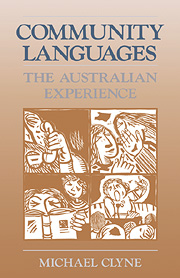Book contents
- Frontmatter
- Contents
- List of tables
- List of graphs
- Map of Australia
- Preface
- 1 Australia between monolingualism and multilingualism
- 2 Distribution and maintenance of community languages in Australia
- 3 The use of community languages in Australia
- 4 Structural and typological aspects of community languages
- 5 The formulation and implementation of language policies
- Appendix
- Glossary
- Bibliography
- Index
1 - Australia between monolingualism and multilingualism
Published online by Cambridge University Press: 09 November 2009
- Frontmatter
- Contents
- List of tables
- List of graphs
- Map of Australia
- Preface
- 1 Australia between monolingualism and multilingualism
- 2 Distribution and maintenance of community languages in Australia
- 3 The use of community languages in Australia
- 4 Structural and typological aspects of community languages
- 5 The formulation and implementation of language policies
- Appendix
- Glossary
- Bibliography
- Index
Summary
INTRODUCTORY REMARKS
Apart from the 150 Aboriginal languages, more than one hundred languages other than English are in use in Australia today. In the 1986 Census, 13.63 per cent of the Australian population (15,604,150 at the time) were reported as using a language other than English at home, and many more employ one away from their home (see below, pp. 39–40). However, it is not only in the post-World-War-II period that Australia could be described as a multilingual society. Ethnolinguistic diversity existed, and, in fact, thrived in some parts of Australia from the early days of European settlement. There were periods during the past 200 years when multilingualism was recognized, or even promoted. There were others when it was ignored, or outlawed.
It has been stated (Bostock 1973) that Australian governments have directed their policies towards achieving monolingualism. And yet Australia has an ethnolinguistic mix probably unparalleled in any other nation. It now has a more comprehensive and positive National Policy on Languages than any comparable country. This paradox is characteristic of a tension that has existed, throughout the history of white settlement in Australia, between three symbolic relationships of language and society: English monolingualism as a symbol of a British tradition; English monolingualism as a marker of Australia's independent national identity; and multilingualism as both social reality and part of the ideology of a multicultural and outreaching Australian society. This tension predates the federation of six British colonies into an Australian nation in 1901, and has not yet been resolved.
The historical relationship of Australians to the Australian national variety of English lies outside the scope of this monograph (see Collins and Blair 1989.)
- Type
- Chapter
- Information
- Community LanguagesThe Australian Experience, pp. 1 - 35Publisher: Cambridge University PressPrint publication year: 1991
- 1
- Cited by



